
|   |

|   |
Natyanjali's Nartaka Festival - Jitendra Krishna e-mail: sathirdance@gmail.com Photos: Ravi Loganathan October 28, 2016 The Nartaka Festival was held on October 21, 22 and 23 at Bharatiya Vidya Bhavan, Chennai. The festival, produced by Prema Satish of Natyanjali Trust, had its 10th edition this year, and has over the last decade showcased Indian classical, contemporary and modern dance. Each year the festival honours a senior dancer with the NARTAKA AWARD for his contribution to dance. This year’s recipient was Sathyanarayana Raju, who also performed at the festival. The focus of this year’s festival was on the timeless varnams of the Thanjavur Quartet, composed for the Maharajas and danced by courtesan dancers during the Thanjavur Raj of the 19th century. The Narthakas were asked to present lesser known varnams of the Quartet. The festival opened with Venkatakrishnan Mahalingam, a senior disciple of the Dhananjayans, who presented the varnam, Adhi moham konden maane in raga Sankarabharanam and adi talam. The varnam is known to most dancers in the original Telugu, Manavi, composed by Thanjavur Quartet Ponnayya. The lyrics for the Tamil version are adapted from this original version by a noted descended of the Quartet, K. Ponniah. The varnam speaks of a courtesan in distress over her absent lover, and her longing for him to return to make love to her: “My lover, my heart is filled with desire, you are a generous man, will you not come back to me? Kamadeva has struck me with his flowery arrows, and now I cannot bear this separation any longer!” The dancer started off well, with clear short appropriate jathis, executed with ease. Unfortunately, the heart of the varnam, with the lyrics in praise of a royalty, Ramalingendran was edited out and the original mood of sringara was lost in translation. Venkatakrishnan’s mudras were clear and his subtle abhinaya was enough to convey the message. He is mostly seen on stage in the role of a nattuvangam artist, supporting other dancers. Hopefully this performance will inspire him to focus on his solo dance. He is certainly an interesting dancer to watch. Musicians for this concert: KP Rakesh – nattuvangam, Murali Parthasarathy – vocal, KP Ramesh Babu – mridangam, Rijesh Gopalakrishnan – violin, Ganesan - tambura 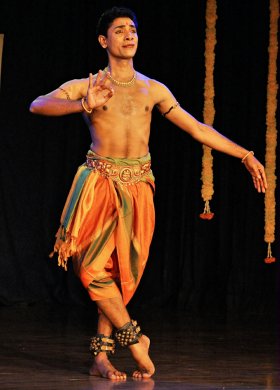 Venkatakrishnan Mahalingam  Sathyanarayana Raj The first day of the festival concluded with a performance by Christopher Gurusamy, disciplined in Bharatanatyam at Kalakshetra. At present he is a freelance dancer who travels the world solo, or as part of several dance companies. Christopher has striking stage presence and film star looks. He also understands ‘less is more’ when it comes to costuming. More than often male dancers are decked up with silk and jewellery, so much, that it is difficult to focus on the dance. Christopher is a strong technical dancer and his abhinaya has improved much over the years. Christopher danced the varnam, Sarojakshiro vibhuni in raga Kambhoji and rupakam, composed by Vadivelu: "My dear friend, now that the evening has come will you bring my lover to me? The time is ripe for lovemaking. Manmathudu has shot his flowery arrows at my bosom, I am overflowing with desire. Please bring him to me!" The beautiful jathis used were all composed by nattuvanars from the Vazhuvoor bani. The execution of the jathis could have been more relaxed. The expression of the lyrics through abhinaya could have had more depth, especially the anupallavi words, “aparamuga ivela bagaina ratiloluni.” With more internalizing of the repertoire, Christopher has all the ingredients to be the superstar Bharatanatyam performer of tomorrow. Musicians for this concert: Sudarshini Iyer – nattuvangam, Murali Parthasarathy – vocal, Karthikeyan Ramanathan – mridangam, Easwar Ramakrishnan – violin. 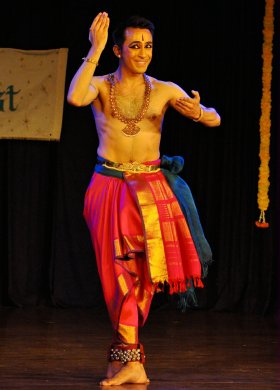 Christopher Gurusamy  Rakesh KP The second day opened with K.P. Rakesh of Kalakshetra, who performed the swarajathi, Sami mel chindai aginen in Chakravakam and rupakam, composed by Ponniah. Rakesh danced an adaptation from the original choreography of Thanjavur Kittappa Pillai, which the dancer failed to mention in the introduction. The poetic lyrics speak of the courtesan’s longing to be with her absent lover: “Dear friend, I am consumed with memories of my compassionate lover, Malugra Pandya. Oh friend, now that I am so anxious with anticipation, why do you act indifferent? Go with my message of love and bring him to me.” Rakesh, who in recent years has been exploring the varnams of the Quartet, danced the swarajathi in an apt mid-tempo pace from start to finish, with “plain” (but excellent) singing of words and notes. The singer wisely avoided trying to make the composition “interesting” with unnecessary sangatis but instead trusted that the emotional content of the words would reach the rasikas. Rakesh's execution of Kittappa Pillai’s theermanams, with complete adavus for right and left, was full of grace. Kittappa Pillai would always consider the music of the varnam before setting theermanams, making sure they blended perfectly with the music. Rakesh’s abhinaya is understated but refined. The dancer is certainly capable to express in detail, even with mere glances. This was especially visible in the later part of the swarajathi, little episodes such as the courtesan dressing up her sakhi before she sends her off to deliver her message of love to her beloved, were done so delicately and beautifully by Rakesh. Rasikas sitting around me reacted to it with praise. Rakesh is a perfect example of an artist who transcends the unnecessary gender binary in Bharatanatyam. Rakesh was certainly the star narthaka of this 2016 edition. Not only did he perform, he was also the nattuvangam artist for three other dancers during the festival! Musicians for this concert: Girish Madhu – nattuvangam, Murali Parthasarathy – vocal, Karthikeyan Ramanathan – mridangam, N. Anantha Narayanan - veena Bengaluru based dancer Adithya, disciple of Gurus Kiran Subramanyam and Sandhya Kiran, presented his first performance in Chennai, and this was also his first attempt at a sringara varnam. The Kalyani varnam, Sarasijakshudu nivani cala ivela is a masterpiece composition of Sivanandam. This exquisite varnam is rarely seen today, but is still performed by dancers belonging to the Thanjavur Balasaraswati bani. The varnam speaks of the desire and longing a woman has for Rajagopala: “My lotus eyed lord, I am overflowing with passion, do not ignore me! Embrace me and make love to me, oh Rajagopala! You who dwells in dakshina dvaraka, will you not come? However much you may be captivated by music and dance, do not leave me!” At the start of the varnam, Adithya entered the stage from the wings as Rajagopala playing his flute. The poetic lyrics deal with the desire and longing a woman has for Rajagopala. The woman in love should have made the entry, if one finds these dramatic entries necessary. The sahityam was a bit slow making the fast paced jathis seem faster than they actually were. The abhinaya portions were mainly descriptive and filled with dramatic poses. The storytelling sancharis such as the raas leela were expressed clearly. Adithya danced what was given to him passionately, and clearly gave everything he had to the varnam. Hopefully he explores the varnam further and doesn't leave it at just this one time. Musicians for this concert: Ramya Janakiraman – nattuvangam, Hariprasad Kaniyal – vocal, Lingaraju – mridangam, Easwar Ramakrishnan – violin. 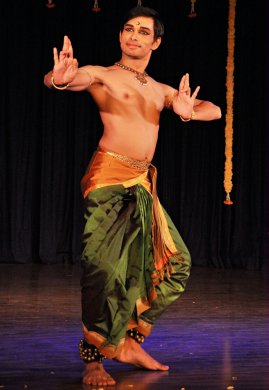 Adithya PV 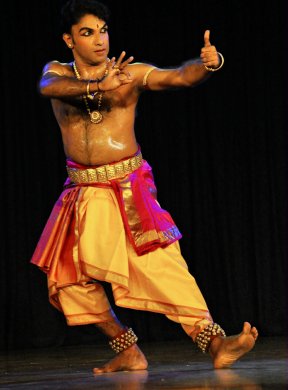 Hari Padma Senior artist of Kalakshetra, Hari Padman, presented another masterpiece composition of Sivanandam, Mohalahiri konden Swamy in the majestic Todi ragam, and adi talam. The varnam speaks of unfulfilled desire and longing of a woman in the absence of Rajagopalaswamy: “Swamy, the love that I have for you has no limits. Every nerve in my body longs to be with you! Why do you pretend to be otherwise engaged? Alas, that wretched Kamadeva has aimed his flowery arrows at me; now I am filled with desire for you! The cool evening breeze stokes a fire inside me. Here I wait for you on a bed made of fragrant flowers; I cannot bear this separation any longer!” The jathis executed with confidence, and the abhinaya had sancharis referring to raas leela, Krishna with the gopis. As what probably comes natural to the dancer, the sringara varnam was turned into a piece soaked in bhakti, with expressions of extreme distress, tearful suffering, and discontent. Intense longing and overflowing desire (due to cupid's arrows) of the lover for the beloved was not seen. Musicians for this concert: KP Rakesh – nattuvangam, Binu – vocal, Karthikeyan Ramanathan – mridangam, N. Anantha Narayanan – veena. 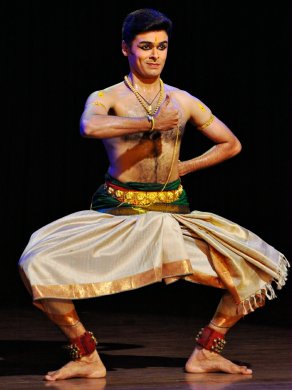 Girish Madhu of Kalakshetra concluded the last day of the festival with the swarajathi, Neeye arulayo Thaaye in the ragam Bhairavi and talam adi, composed by the Quartet, set to dance at first by the late Gopalakrishnan Pillai, grandson of Pandanallur Meenakshisundaram Pillai. The swarajathi says: “Oh thaaye, will you shower your grace upon me? Mother, please accept my offerings at your lotus feet. Seated at the left side of Lord Shiva, please remove our sorrows.” Girish filled the piece with storytelling sancharis, all done with clarity in the used mudras, which even those unfamiliar with the stories can understand. If only Girish would relax his face muscles, just for a minute, the rasikas could soak up more. The jathis had pleasant adavu combinations, danced with strong and clear footwork. Girish's makuta adavu is a work of art in itself, indeed a pleasure to look at, done with such grace and beauty. Musicians for this concert: KP Rakesh – nattuvangam, Hariprasad – vocal, Vedakrishnaram – mridangam, Easwar Ramakrishnan – violin. “It's hip to be square and dance a piece that is rare!” With more and more dancers performing “rare” Thanjavur Quartet varnams, the compositions are back in vogue. The question is, can you just pick up these pieces and compose dance for them? Are just lyric, translation and notations enough? The poetry may seem simple enough but the varnams are multilayered with underlying meanings, often filled with subtle sarcasm or tongue-in-cheek. The varnams also have social historical context which needs to be looked at. All this is not necessarily revealed when one just looks at the lyrics. Since the nattuvanars are gone (mostly) the next best thing is to learn the varnams from their disciples (in particular, those who have learned for longer periods under a nattuvanar). These masterpiece compositions should be handled with the utmost care and with respect to the composers. Jitendra Krishna is artistic director of Sathir Dance Art, Chennai-Amsterdam. |